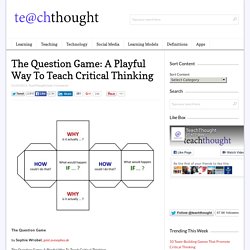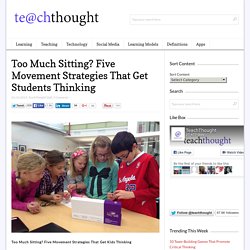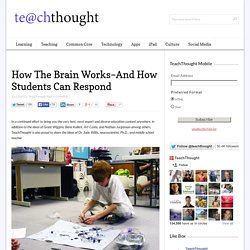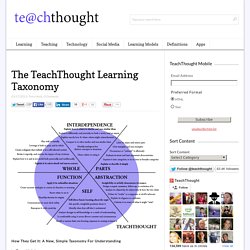

Self-Service - Attendance. Bloom's Digital Taxonomy. The Question Game: A Playful Way To Teach Critical Thinking. The Question Game by Sophie Wrobel, geist.avesophos.de The Question Game: A Playful Way To Teach Critical Thinking Big idea: Teaching kids to ask smart questions on their own A four-year-old asks on average about 400 questions per day, and an adult hardly asks any.

Our school system is structured around rewards for regurgitating the right answer, and not asking smart questions – in fact, it discourages asking questions. In A More Beautiful Question: The Power of Inquiry to Spark Breakthrough Ideas, Warren Berger suggests that there are three main questions which help in problem solving: Why questions, What If questions, and How questions. Regardless of the question, the question needs to be phrased openly and positively in order to achieve positive results – a closed or negative question only raises bad feelings against each other. Why questions help to find the root of a problemWhat If questions open up the floor for creative solutionsHow questions focus on developing practical solutions. 5 Movement Strategies That Get Students Thinking. Too Much Sitting?

Five Movement Strategies That Get Kids Thinking by Kenny McKee Each day more research confirms the link between movement and learning. Brain researcher David Sousa claims that physical activity increases the amount of oxygen in our blood, and this oxygen is related to enhanced learning and memory. A recent Washington Post article suggests that many student behaviors we associate with ADHD may stem from an overall lack of physical movement – both in and out of school. However, many secondary teachers struggle to integrate movement into the classroom. I’ve included some strategies that teachers of any content area can use to integrate movement into lessons. 1.
In some lessons, students may need to analyze multiple texts. Gallery walks can also feature student-created texts, even digital ones. Chalk Talks are gallery walks where students are asked to respond to texts. 2. White Board Meetings are a strategy I have seen two science teachers use often. And How Students Can Respond. In a continued effort to bring you the very best, most expert and diverse education content anywhere, in addition to the ideas of Grant Wiggins, Bena Kallick, Art Costa, and Nathan Jurgenson among others, TeachThought is also proud to share the ideas of Dr.

Judy Willis, neuroscientist, Ph.D., and middle school teacher. By Dr. Judy Willis Although the brain is an amazing organ, it’s not equipped to process the billions of bits of information that bombard it every second. Filters in your brain protect it from becoming overloaded. The Neuroscience Behind Stress and Learning. The realities of standardized tests and increasingly structured, if not synchronized, curriculum continue to build classroom stress levels.

Neuroimaging research reveals the disturbances in the brain's learning circuits and neurotransmitters that accompany stressful learning environments. The neuroscientific research about learning has revealed the negative impact of stress and anxiety and the qualitative improvement of the brain circuitry involved in memory and executive function that accompanies positive motivation and engagement. The Proven Effects of Positive Motivation Thankfully, this information has led to the development of brain-compatible strategies to help students through the bleak terrain created by some of the current trends imposed by the Common Core State Standards and similar mandates.
With brain-based teaching strategies that reduce classroom anxiety and increase student connection to their lessons, educators can help students learn more effectively. Better Teaching: Why You Bore Students & What You Can Do About It. Preface: You don’t mean to bore students.

In fact, sometimes you’re downright interesting–the students are engaged, the buzz in the room is palpable, and even the hesitant students are asking questions. But the fact of the matter is, even the most charismatic and experienced teachers bore students sometimes. But the good news is, it may not be your fault. Judy Willis explains the neuroscience behind it all, and offers some simply tricks to help mitigate the reality that you and your content are instinctively low on a student’s neuro totem pole. Oh–the article’s title was our idea, not Judy’s. ; ^ ) by Judy Willis M.D., M.Ed., radteach.com Better Teaching: Why You Bore Students & What You Can Do About It A few thousand years ago, in 360 B.C., Plato advised against force-feeding of facts to students. “Elements of instruction…should be presented to the mind in childhood; not, however, under any notion of forcing education.
How They Get It: A New, Simple Taxonomy For Understanding. How They Get It: A New, Simple Taxonomy For Understanding by Terry Heick How can you tell if a student really understands something?

They learn early on to fake understanding exceptionally well, and even the best assessment leaves something on the table. (In truth, a big portion of the time students simply don’t know what they don’t know.) The idea of understanding is, of course, at the heart of all learning, and solving it as a puzzle is one of the three pillars of formal learning environments and education. 1. 2. 3. But how do we know if they know it? Understanding As “It”